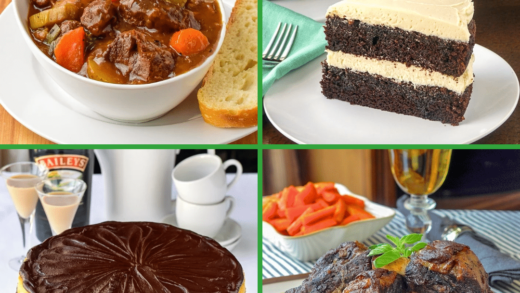![]()
Diana Barkley
(Senior Editor)
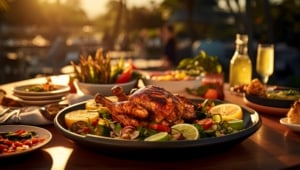
Ever wanted to experience the vibrant flavor of Brazilian food without leaving your kitchen? Well, you can now! In this post, we’ll walk you through everything you need to know about Brazilian cuisine. We’ll also share some mouthwatering recipes for the most popular Brazilian dishes.
Brazilian food is a flavorful journey from the notorious feijoada and farofa to the hidden gems waiting to be discovered. It’s influenced by the different cultures that have settled in Brazil, including Asian, African, European, and Amerindian cultures.
Thanks to the influence of these cultures, Brazilian food is characterized by using a wide range of ingredients, from traditional staples like beans and rice to exotic native fruits and vegetables. Pack your appetite, and let us take you on a journey to discover Brazilian cuisine.
Traditional Brazilian Cuisine – More Than Feijoada and Moqueca

Traditional Brazilian Cuisine – More Than Feijoada and Moqueca
Traditional Brazilian cuisine is an astonishing tapestry of flavors and culinary prowess that extends beyond internationally acclaimed dishes like moqueca and feijoada. While these iconic dishes have earned their well-deserved spots internationally, they’re just the tip of the iceberg.
Brazilian food is a captivating mix of cooking styles and traditions from different regions. Think of a blend of African, European, Amerindian, and Asian flavors. The result? Exotic and rich cuisine that has something for every palate.
Since Brazil’s total area is more than 8.5 million km2 and is home to more than 200 million people, every region has unique dishes and cooking techniques.
Brazilians typically use ingredients that originally came from the native people, such as cumaru, tucupi, cassava, açaí, guaraná, and cashews. But over time, as different groups of people moved into Brazil, they brought their flavors and recipes.
Enslaved Africans, for example, played a significant role in the evolution of Brazilian food, especially in coastal regions. Similarly, European immigrants from Portugal, Italy, Spain, Germany, and many other countries also introduced leafy vegetables, dairy products, and wine to Brazilian cuisine.
Later on, Japanese people brought a bunch of foods and ingredients that we now think of as Asian cuisine in Brazil.
Traditional Brazilian cuisine is as diverse as the country itself because every region has its distinct dishes. For example, in the Southern region of Brazil, churrasco, the Portuguese name for barbecue, is extremely popular.
That’s mainly because the Southern region is near Argentinian and Uruguayan pampas, where livestock thrives as a primary economic activity and the culinary tradition is based on meat consumption.
The Mid-Western Brazilian cuisine is one of the most diverse in the country. That’s because it’s influenced by Indian, European, and African cuisines. The cuisine mainly involves meat-based dishes and local fruits and vegetables such as Pequi.
Speaking about distinctive regional cuisines in Brazil, we must mention Bahia and Minas Gerais. The Bahian cuisine features a lot of African delicacies such as vatapá, abará, and acarajé.
Meanwhile, Minas Gerais cuisine is influenced by European dishes and dairy products such as Minas cheese, feijão tropeiro, and pão de queijo.
If you’re a seafood fan, you’ll enjoy food in Santa Catarina as it’s a seafood heaven. The oysters from Florianópolis are famous nationwide, but the regional cuisine is also full of varieties of shrimp and fish.
While popular Brazilian dishes like feijoada, moqueca, and Vatapá are staples in Brazilian cuisine, there’s a plethora of other regional dishes, too. Let’s look at some of the most popular Brazilian dishes.
Most Popular Street Food in Brazil
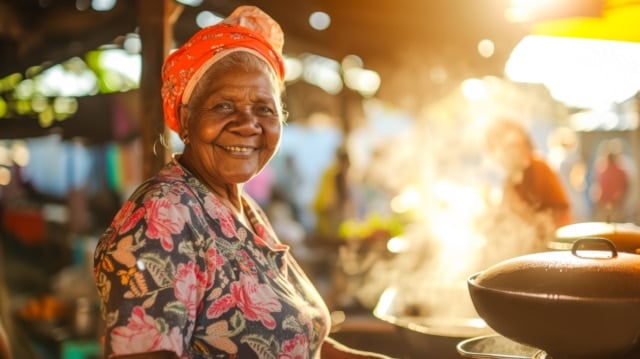
Most Popular Street Food in Brazil
Brazilian street food is a must-try if you’re visiting such a diverse country. Eating like a local is the best way to experience the vibrant culture of Brazil. Fortunately, street food plays a significant role in everyday life in Brazil.
From light snacks like pão de queijo to spicy treats like acarajé with vatapá, you can find the best of Brazil’s sweet and savory street food at every corner. Here are some of the most popular Street food in Brazil:
- Pastel: They’re deep-fried pastries filled with ingredients such as cheese, minced meat, shrimp, and heart of palm. If you have a sweet tooth, you can enjoy pastels with chocolate, caramel, and tropical fruits.
- Coxinha: These are crunchy, deep-fried doughs filled with shredded chicken and creamy cheese. Coxinha is native to São Paulo, but it’s now served in many other parts of Brazil.
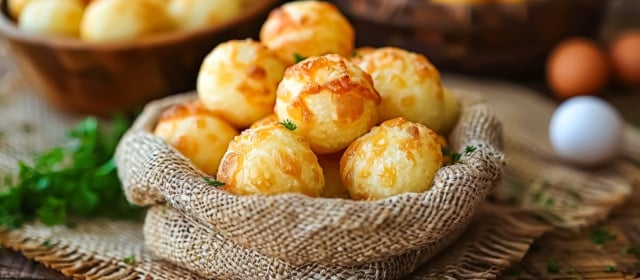
Pão de queijo
- Pão de queijo: A popular breakfast and snack in Brazil that consists of light and fluffy cheese bread. They’re often stuffed with cheese, but you can order them jam-stuffed if you want a sweet treat.
- Bolinhos de Bacalhau: These are crispy codfish fritters that consist of mashed potatoes, onions, eggs, parsley, spices, and dry salted cod. It’s a beloved snack in Southern Brazil and northern Portugal.
- Acarajé: A notorious street food from Bahia, which consists of deep-fried black-eyed peas or cowpeas stuffed with shrimp, palm oil, cashews, and spices.
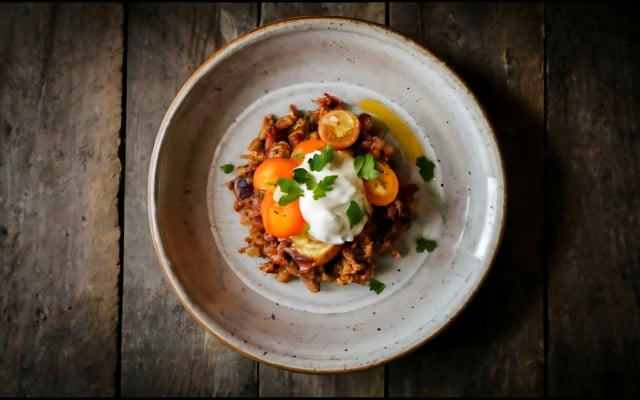
Arrumadinho
- Arrumadinho: A Brazilian appetizer that features a blend of sliced dried beef, black-eyed peas, diced vegetable vinaigrette, and farofa (toasted cassava flour).
- Brigadeiro: Traditional Brazilian sweets made from butter, sweetened milk, cocoa powder, and chocolate sprinkles. They’re very popular among children, but adults love them too.
As you can see, street food in Brazil packs a punch of flavors and ingredients that fit every taste bud. Due to Brazil’s eclectic population and culture, street food is a fusion between European, African, Asian, and Amerindian cuisines.
But who said you have to travel to Brazil to get a taste of Brazilian cuisine? Luckily, Brazilian food is available in many parts of the world.
How Healthy Is Brazilian Food?
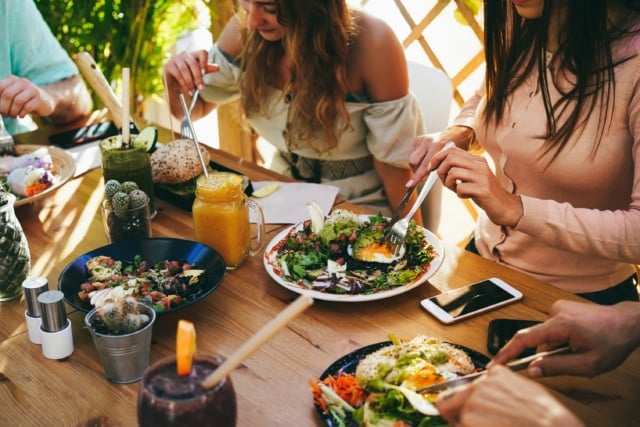
How Healthy Is Brazilian Food?
Since Brazil is a rapidly developing nation, it has embraced consumerism alongside its growing prosperity. As a result, you’ll see fast food and soft drinks dominate the Brazilian diet. But does that mean Brazilian food isn’t healthy?
Not exactly. Thanks to its diversity and incorporation of ingredients from many other cultures, Brazilian food can be healthy for those watching their weight. Here are some popular Brazilian dishes and their benefits.
Yam (Inhame)
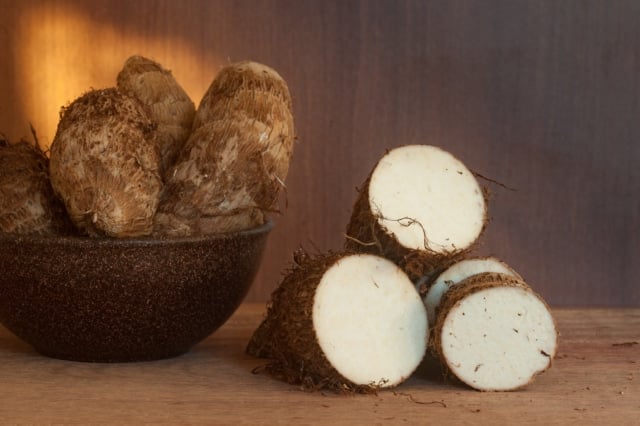
Yam (Inhame)
Yam, also known as Inhame in Brazil, is a widely popular root that goes into many Brazilian dishes. These nutritious, dense roots are nutritional powerhouses as they contain proteins, fibers, vitamins, and minerals.
They’re particularly rich in manganese and potassium, which are essential for growth, metabolism, bone health, and heart function.
Additionally, yams can enhance brain function as they contain diosgenin, which promotes neuron growth and improves brain functions such as memory and learning abilities.
For women, eating yams can be beneficial in easing the symptoms of menopause. According to a study, yams increase estrogen levels in women, easing menopause symptoms.
That’s not the end of it. Yams are also rich in antioxidants, and it’s believed that they have anti-cancer properties, but more studies are needed to confirm this.
Moreover, the nutritional profile of yams supports digestion, enhances energy levels, and reduces sugar assimilation.
Manioc (Cassava)
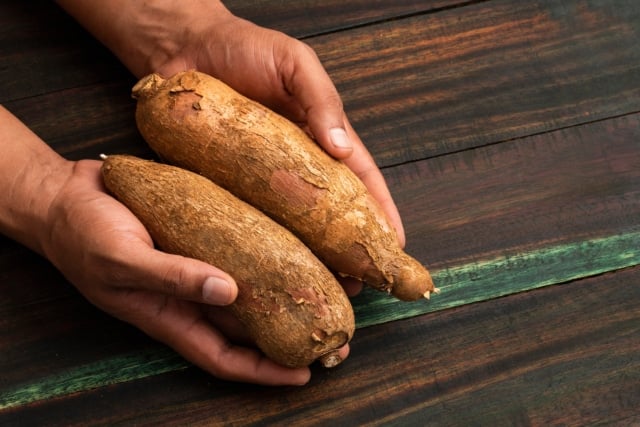
Manioc (Cassava)
Manioc or cassava is another popular energetic root in Brazil, and it’s the traditional food of the poor. Cassava can be boiled and served as a side dish, made as flour, offered as farofa, or steamed or deep fried.
Thanks to its versatility, manioc goes into multiple Brazilian dishes. The best part? It’s healthy and rich in minerals such as iron, phosphorus, and calcium.
They also contain vitamin B complex and are gluten-free, so they’re ideal for those with celiac disease or who prefer gluten-free food options.
Açaí

Açaí
Brazilian açai berries stand out as a potent source of beneficial antioxidants as they have 10 times more antioxidants than cranberries. They flourish in tropical regions and are widely used in jams, wines, ice creams, and energy juices.
Apart from antioxidants, açai berries are rich in fiber, protein, vitamins A, C, B1, and B2, and essential minerals like iron, calcium, and phosphorus.
Notably, the high calcium content (10 mg for every 100 g) aids in bone and teeth formation, which is beneficial in preventing bone diseases such as osteoporosis.
Brazil Nuts

Brazil Nuts
Brazil nuts, also known as Castanha do Para, stand out as one of the richest sources of selenium out there, known to potentially offer protection against Alzheimer’s disease, depression, and cancer.
These nuts boast a complete protein content as they contain all the essential amino acids needed for humans. Brazil nuts can also be beneficial in the following:
- Combating cellular aging
- Detoxification from heavy metals
- Improving thyroid function
- Strengthening the immune system
- Inhibiting the spread of cancer cells
- Reducing bad cholesterol (LDL) and increasing good cholesterol (HDL)
- Preventing the development of heart conditions
Black Beans

Black Beans
Black beans are often considered Brazil’s culinary emblem and national pride. Why? Because feijoãda is the national dish served across every state. Black beans offer a decent amount of protein and fiber. They contain 15 grams of both nutrients.
This nutritional profile, coupled with high magnesium and folic acid levels, offers significant benefits for the digestive tract and cardiovascular system.
It also prevents free radical formation and regulates blood sugar levels. In addition, black beans contain a high amount of fiber, which helps reduce the amount of bad cholesterol in the blood by facilitating the elimination of bile acids.
Cashew Fruit
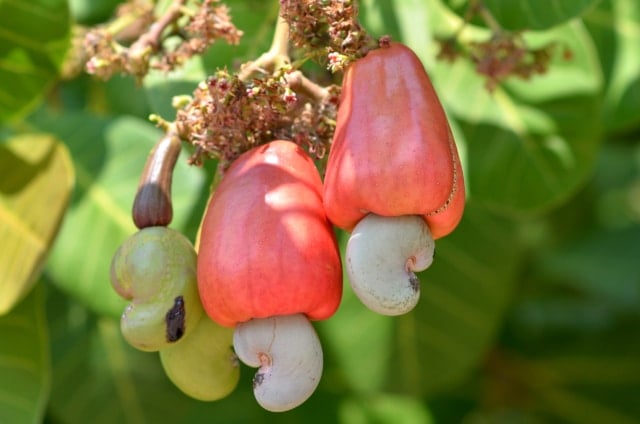
Cashew Fruit
Cashew, found throughout Brazil and predominantly in the Northeastern state of Ceara, is a fruit with a unique sweet and sour taste.
This fruit is famous for its remarkably high levels of vitamin C, with 220 mg per 100g, surpassing kiwis and oranges. Cashew fruits are also rich in minerals (calcium, iron, phosphorus), Vitamins (A, B1, B2, B3), amino acids, and fibers.
Cashew fruits also have powerful antioxidant and detoxifying properties, and that’s why cashew juice is recommended for anemia, rheumatism, skin conditions, and bone strengthening.
Famous and Popular Brazilian Dishes You Have to Try
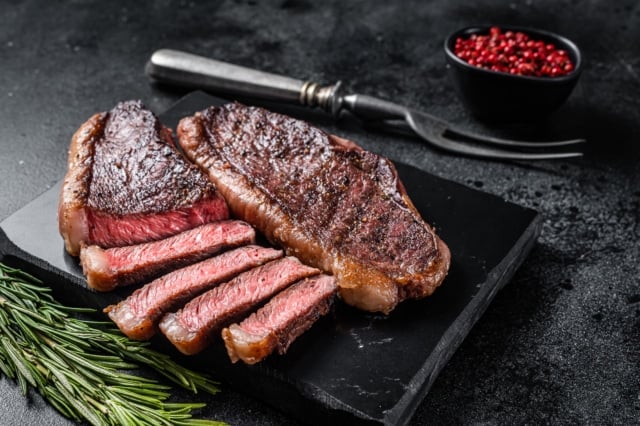
Famous and Popular Brazilian Dishes You Have to Try
If you’re trying Brazilian cuisine for the first time, it’s tough to know where to start. Should you go with the traditional feijoada? Or maybe try moqueca or picanha?
Brazilian food is diverse, and even though meat-based meals pop up across the country, there are multiple food offerings to try. To help you narrow down your options, let’s check out this list of must-try Brazilian dishes.
Feijoada
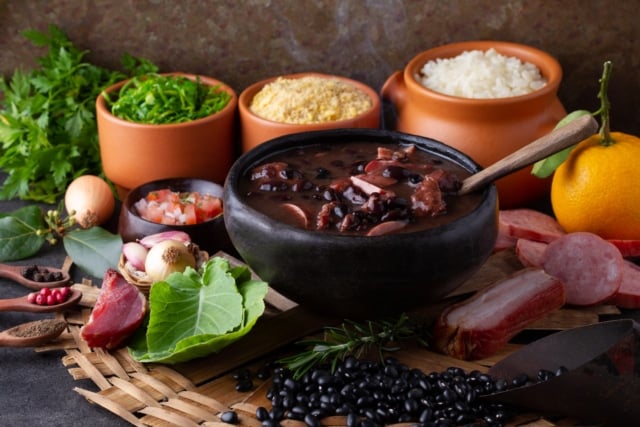
Feijoada
In South America, soups hold a significant culinary importance, and Brazil is no exception. You can’t be in Brazil and not encounter feijoada, a hearty stew featuring beef, beans, and pork.
This hearty mix is ideal for warming up on chilly winter nights, but in Brazil, you’ll find people enjoying feijoada, even on a sunny day at the beach.
Since feijoada is a nation’s favorite, you’ll find numerous variations for it depending on where you are in Brazil. Variations range from pork sausage to shredded meat, but most feijoadas will have a deep brownish-black appearance.
Like many other Brazilian dishes, feijoada embodies diverse cultural influences, not only from Portugal and Africa but from India as well. This showcases that Brazil is the multi-cultural melting pot of South America.
Picanha
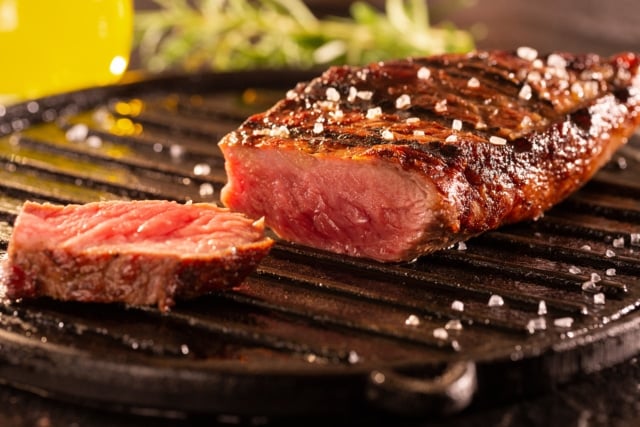
Picanha
Picanha is a widely popular cut of meat in Brazil, and it’s not recognized in the United States. It’s the equivalent of a top sirloin cap or a rump cap in the U.S., and in Argentina, it goes by the amusing name “bief Americanos.”
This interesting type of meat cut involves taking the edge of the top sirloin, including a silver of fat, and cutting the protein about an inch below the fat.
The result? A thick one or two inches of protein with a top silver of fat. When skewered and grilled, the fat-muscle combination yields a cut that’s easy to pierce or eat without extra cutting post-grilling.
Farofa

Farofa
In the mood for a hearty smokey dish? Try out farofa, a widely popular Brazilian dish featuring small fried bacon pieces, cassava flour, salt, smoked meat, and a blend of spices. The texture of farofa ranges from large grains to table-salt-sized powder.
With its smokey and slightly salty flavor, farofa complements different meat-based dishes, especially hearty stews and barbecued meat.
The traditional Brazilian farofa recipe combines cassava flour with oil, salt, bacon, onions, garlic, sausage, butter, and olives. Farofa is often paired with barbecue and feijoada, but it’s also used as stuffing in poultry and other dishes containing nuts, fruits, and raisins.
Vatapá
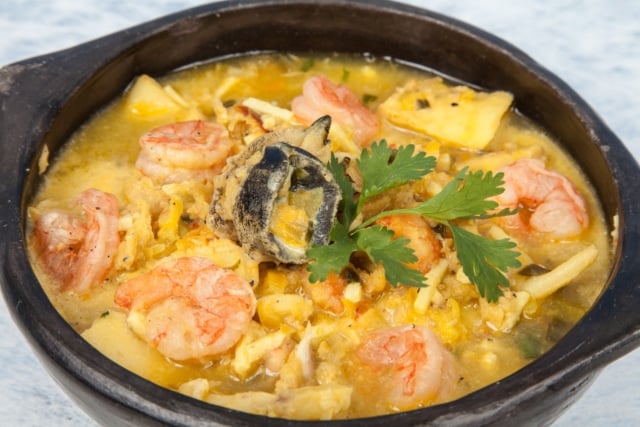
Vatapá
Inspired by the African culture, vatapá is a must-try flavorful dish that’s widely popular in Brazil, especially in Bahia. The dish features a rich, creamy stew made from bread, ground peanuts, coconut milk, shrimp, and palm oil.
However, many variations involve switching out shrimp for chicken, cod, tuna, or vegetables.
What makes vatapá special is that it’s a complex and harmonious combination of flavors and textures.
The nuttiness from ground nuts, the creaminess of coconut milk, and the savory depth from shrimp create a symphony of taste that tantalizes your taste buds.
Bobó de Camarão

Bobó de Camarão
Bobó de Camarão is another popular dish in Bahia that’s ideal for seafood lovers. The dish features a creamy, flavorful shrimp stew with ingredients like dendê oil (palm oil), coconut milk, manioc, onions, and various spices.
Soups and Salads

Soups and Salads
Soups and salads are staples in South American cuisine, especially in Brazilian dishes. Rooted in a rich blend of African, Portuguese, and Asian influences, Brazilian soups and salads offer a symphony of flavors that complement every meal.
From hearty stews like feijoada to refreshing salads like salpicão, every dish tells a story of tradition, regional ingredients, and a celebration of local products. Let’s look at some of the most popular Brazilian soups and salads.
Tacacá

Tacacá
Tacacá is a traditional Brazilian soup that originates from the Amazonian region of Brazil, typically in Amazonas, Acre, Amapá, and Roraima. The primary components of tacacá include jambu leaves, dried shrimp, tucupi, manioc, and sometimes, yellow pepper.
This soup is famous for its tingling sensation induced by the jambu leaves. It’s often served hot, and the contrast of flavors and textures results in a flavorful, aromatic stew that you must try.
Moqueca

Moqueca
Moqueca is a fantastic seafood stew from Brazil that can be whipped up with fish, shrimp, or a mix of both.
Traditionally, Brazilians use cação, a type of shark, and cook it all up in a clay pot to prepare this stew. Like many other Brazilian dishes, it’s believed that moqueca has Portuguese and African origins.
There are two main versions of moqueca: Moqueca baiana and Moqueca capixaba. Baiana, as the name suggests, is developed in the state of Bahia, and it features a mix of coconut milk and dendê oil.
Meanwhile, capixaba is the lighter and milder moqueca version, as it utilizes annatto and olive oil.
Caldo de Piranha
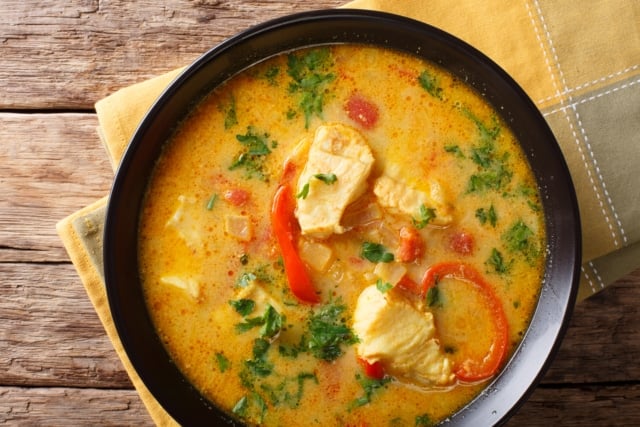
Caldo de Piranha
Caldo de Piranha is another delicious Brazilian soup from the Pantanal region. It’s prepared with piranha fish, tomatoes, annatto, chili peppers, onions, and herbs like coriander and parsley.
Other versions of Caldo de Piranha include bell peppers, vinegar, lime juice, and garlic. Legend has it that Caldo de Piranha enhances virility in men.
Salpicão de Frango
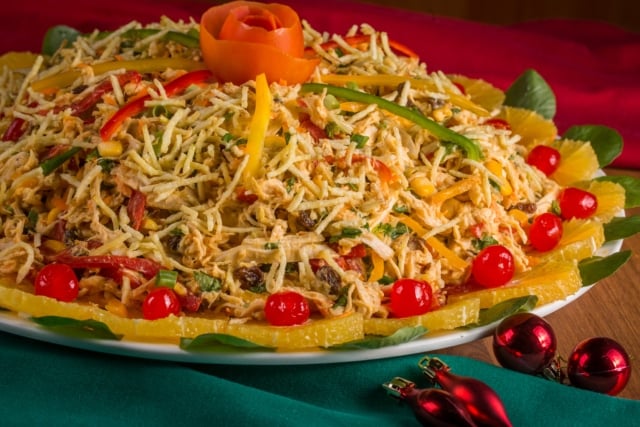
Salpicão de Frango
Salpicão de Frango, simply called Brazilian chicken salad, is a refreshing mix of chicken breasts and veggies topped with potato sticks and tossed in mayonnaise.
This salad stands out for its ease of preparation as all you need to do is cook the chicken breasts, add the rest of the ingredients, mix well, and then enjoy.
Starters and Sides
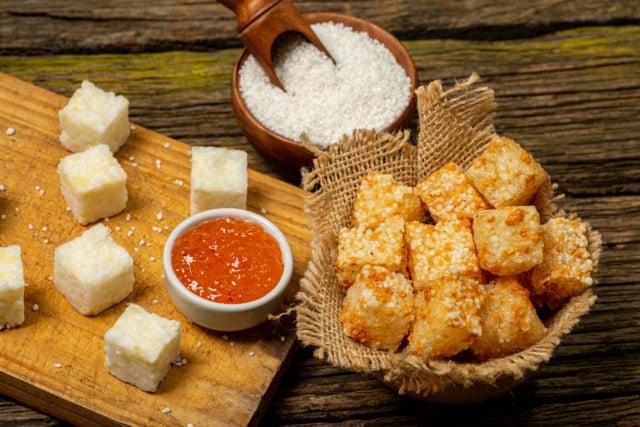
Starters and Sides
Given the variety of hearty dishes in Brazilian cuisine, it’s hardly surprising that there’s an extensive array of starters and appetizers perfect for lunch or dinner. If you’re looking to begin your meal with delectable starters, here’s a curated list of some of the most popular Brazilian appetizers:
- Coxinhas: Bite-sized snacks crafted from shredded chicken, spices, and mashed potatoes. Coxinhas are often deep-fried to achieve a crispy perfection, and their shape cleverly resembles drumsticks.
- Empadinhas: Petite pies featuring a crispy golden crust, generously filled with options like chicken, cheese, and beef. Variations of empadinhas also include enticing combinations with vegetables, seafood, and other flavorful ingredients.
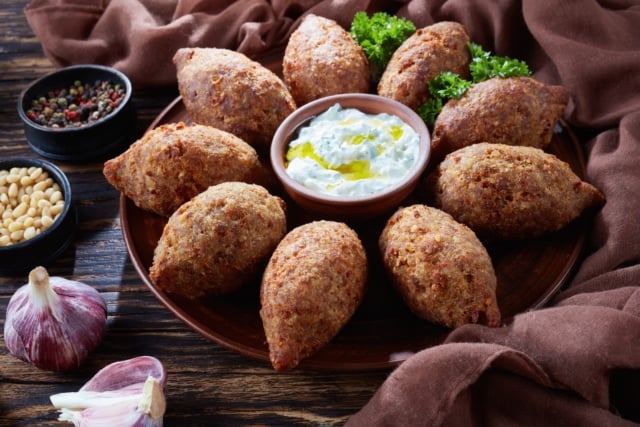
Kibe
- Kibe: Petite ground beef croquettes seasoned with a blend of garlic, onions, cinnamon, and mint. Originating from Lebanon, these savory delights have found widespread popularity throughout Brazil.
- Esfihas or Esfirras: Savory pastries with roots in the Middle East. Crafted with thin, flaky dough, they come topped or stuffed with a delightful mix of cheese, meat, and vegetables.
Sandwiches
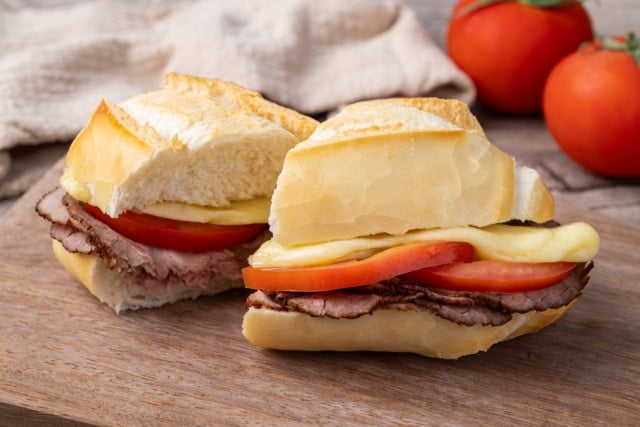
Sandwiches
Brazil is known for its diverse and delicious culinary options, and sandwiches are no exception. From meat-based sandwiches like Bauru to fresh corn-based pamonha, here are the best Brazilian sandwiches to try:
- Bauru: An iconic Brazilian sandwich that originates from São Paulo. It’s filled with melted cheese, roasted beef, sliced pickles, and tomatoes. There are numerous variations to bauru, such as switching roasted beef with sliced ham.
- Sanduiche de mortadella: A hearty sandwich featuring a simple bread roll stuffed with sliced mortadella and covered with melted cheese.
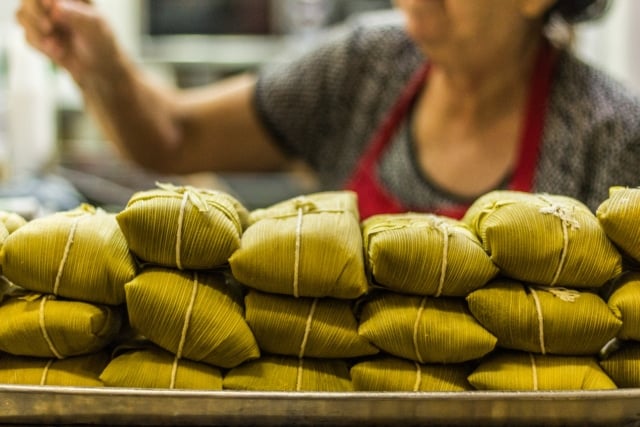
Pamonha
- Pamonha: Sweet or savory Brazilian dish made with freshly grated corn tightly wrapped around a fresh corn husk.
- Beirute: A traditional Brazilian sandwich that originates from São Paulo and is influenced by Syrian-Lebanese cuisine. It features Syrian bread stuffed with roast beef, tomatoes, lettuce, melted cheese, and a mixture of herbs and spices.
- X-Tudo: A tall Brazilian burger that doesn’t have fixed ingredients but is always topped with various toppings. This burger often features bacon, beef patties, tomatoes, sausages, melted cheese, corn, and more.
Mains
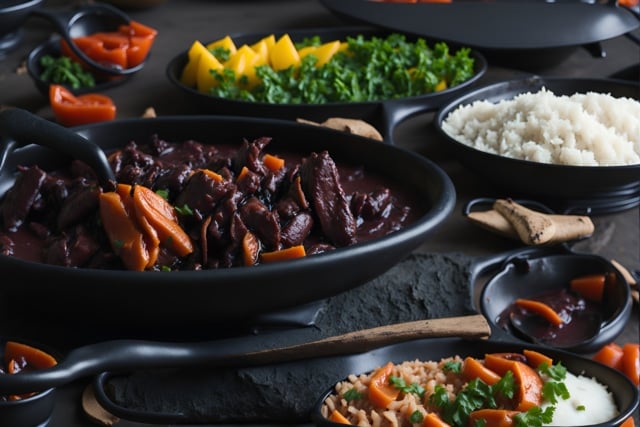
Mains
As we mentioned, Brazilian cuisine is a celebration of diverse ingredients, vibrant flavors, and rich cultural heritage. At the heart of this culinary mosaic lies a collection of main dishes that are influenced by numerous cultures.
But where should you start? Should you begin with the most traditional dishes like feijoada? Or indulge in some deep-fried pastels? Let’s check out the most popular Brazilian main dishes.
Feijoada
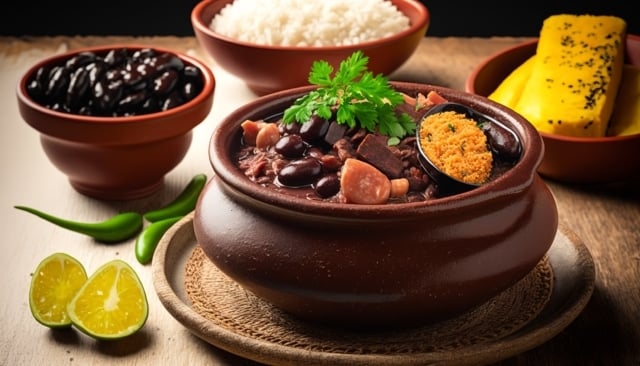
Feijoada
Feijoada stands out as a cherished favorite among Brazilians, especially the locals. While a popular Brazilian legend attributes its origin to Brazilian slaves repurposing their owners’ leftovers, the true roots of feijoada trace back to the Portuguese influence in South America.
The national dish of Brazil is inspired by a stew from the Roman Empire that features meat, vegetables, and white beans. But the Brazilian version incorporates pork and local black beans, adding a unique, flavorful twist.
Feijoada is served in almost every Brazilian buffet, but it truly shines when ordered a la carte paired with the classic caipirinha.
Baião de Dois
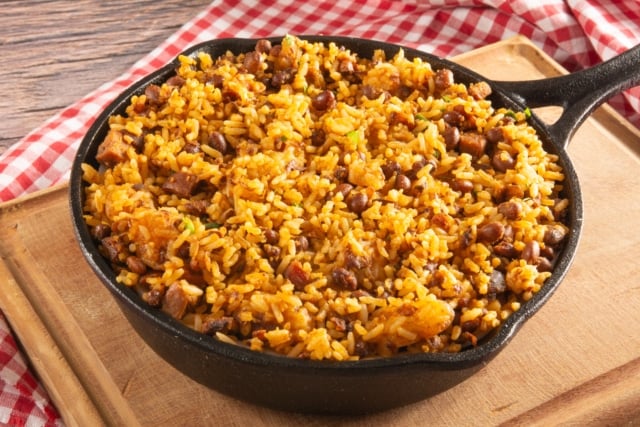
Baião de Dois
Baião de Dois is a delightful Brazilian main dish hailing from the north and northeast of Brazil. The dish typically features rice and beans, sometimes with the addition of curd cheese.
Though Baião de Dois is mainly popular in Ceará State, it’s also served in other states with different variations that include bacon, onions, oil, and garlic. The variations depend on the area, available ingredients, and local weather, but they’re all mouthwatering.
Churrasco

Churrasco
If you’re a carnivore, you’ll enjoy churrasco, the traditional Brazilian barbecue method. The secret to its appeal lies in the thin slices of skirt steak that are grilled to perfection, resulting in tender, juicy meat.
The steak is elevated with flavorful sauces, onion, garlic, olive oil, and a blend of spices and herbs for a delightful finish. Churrasco offers a flavorful experience, even though it’s recognized as a tougher cut due to the abundance of connective tissue.
Galinhada

Galinhada
For chicken lovers, Galinhada is a must-try Brazilian dish. It’s a one-pot wonder that includes rice cooked with succulent chicken pieces and aromatic spices.
The dish originated from the states of Minas Gerais and Goiás, but it was the Portuguese who brought it to Brazil.
Galinhada can be easily prepared by seasoning chicken pieces to perfection and then simmering them with rice and ingredients such as onions, tomatoes, bell peppers, garlic, and herbs.
Bread, Pastries, Dessert

Bread, Pastries, Dessert
Brazilian cuisine isn’t just about main dishes and appetizers. It also offers a wide array of bread, pastries, and dessert options.
From iconic staples like Pão de queijo (cheese bread) to chocolate truffles such as Brigadeiro, you can indulge in a variety of sweet and savory Brazilian delicacies. Let’s take a closer look at the most popular Brazilian bread, pastries, and desserts.
Pão de queijo: Traditional Brazilian cheese bread balls made from tapioca flour and filled with Minas cheese.
Pão francês: Unique Brazilian bread rolls characterized by a soft crumb and a golden crispy shell. It has different names throughout Brazilian states, such as pão filão, pão Jacó, and pão aguado.
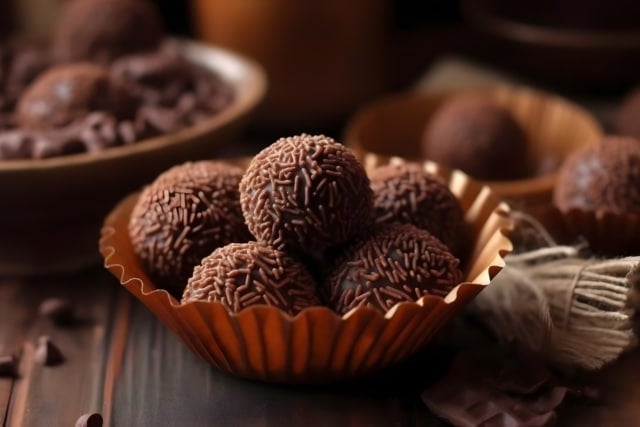
Brigadeiro
Brigadeiro: An iconic Brazilian chocolate truffle made with cocoa powder, condensed milk, and butter and covered with chocolate sprinkles.
Coxinha: Crunchy savory pastry that looks like a drumstick filled with shredded chicken and deep fried. It’s often served in social gatherings, parties, and festivals.
Canjica: A classic Brazilian sweet dish often served in winter festivals. It’s a porridge made with maize kernels and other ingredients like milk, sugar, cinnamon, and peanuts.
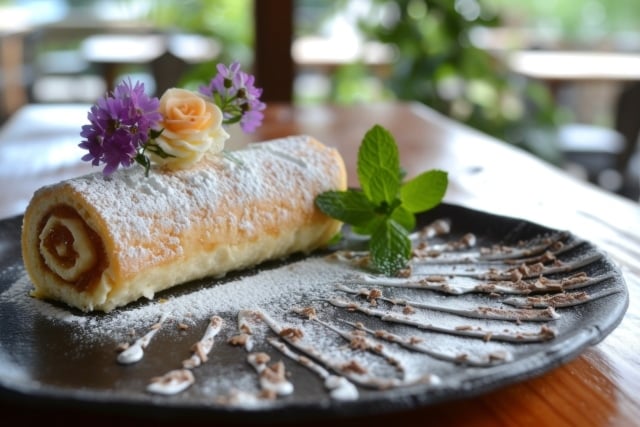
Bolo de Rolo
Bolo de Rolo: Rolled sponge multi-layer cake that’s often prepared with guava paste. Sometimes, layers of marmalade or dulche de leche are used instead of guava.
Cuca de Banana: Delicious German-inspired banana cake that combines the sweetness of ripe bananas with a rich crumb topping.
Mousse de Maracuja: A passion fruit-flavored version of mousse that’s prepared using egg whites, gelatin, condensed milk, and concentrated passion fruit juice.
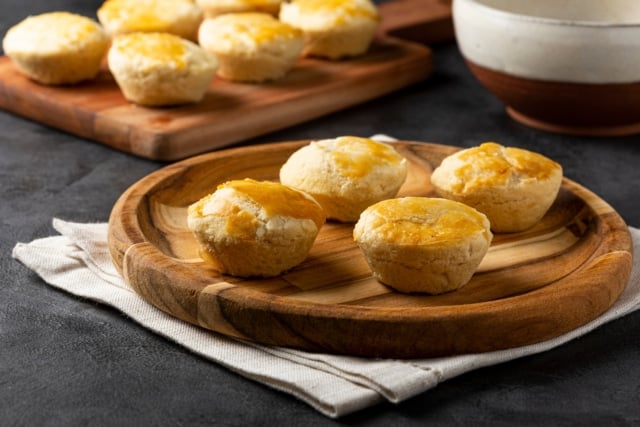
Empada
Empada: The Brazilian version of empanadas. It’s a baked or deep-fried pastry filled with meat, cheese, or fruits, making it a perfect snack, appetizer, or dessert.
Paçoca: A popular Brazilian peanut brittle-like candy that’s widely served in Minas Gerais and São Paulo. It has a unique nutty and sweet flavor and a crunchy texture.
Beijinhos: Coconut confections made from condensed milk, shredded coconut, and egg yolk. They’re the coconut version of Brigadeiros and are often topped with cloves.
Three Secret Recipe Tips

Three Secret Recipe Tips
Want to unlock the full potential of Brazilian cuisine? You’re in luck. We’ll share some secret recipe tips to help you recreate traditional Brazilian dishes at home. Let’s check them out.
Try Using a Pit Oven

Try Using a Pit Oven
Traditional Brazilian food is often cooked using a pit oven. Sounds pretty old school, right? Well, it’s one of the oldest cooking structures out there. But how does it work?
To make a pit oven, you need to dig holes in the ground and fill them with hot stones of different sizes. Place the biggest rocks at the bottom and stack smaller ones on top.
After that, cover the pit using tree branches or a modern cooking tray. Finally, pile on your meat and veggies to get them ready for a slow roast. Cover everything up to keep the heat and steam in place.
Learn Churrasco Style

Learn Churrasco Style
Churrasco means barbecue in Portuguese, but it’s not just an ordinary barbecue. In Brazil, churrasco is an incredibly popular cooking method, especially when it comes to grilling beef and other meat types. The secret behind this method is using charcoal as a heat source.
But the magic of churrasco doesn’t stop there. One of the things that sets this cooking method apart is the use of chimichurri sauce. It’s not like the average barbecue sauce.
It’s made from vinegar, garlic, oil, and herbs, adding a tangy kick to the meat and creating a unique blend of earthy and smokey flavors.
Try Slow Cooking
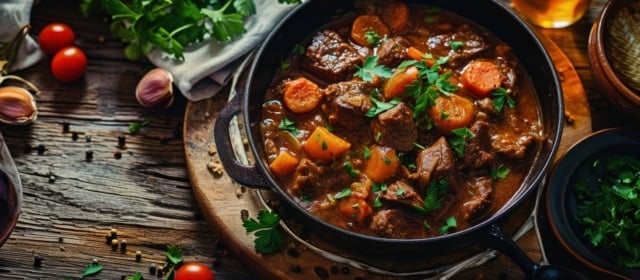
Try Slow Cooking
Have you ever wondered how Brazilian meat has that tender, juicy flavor that melts in your mouth? Here’s the secret: slow cooking. It can be a game-changer in achieving a moist, tender texture, especially when cooking beef dishes.
Slow cooking is all about allowing the meat to gently simmer over low heat for extended periods (up to 10 hours).
That way, slow heat allows the meat juices to fully soak in, creating an explosion of flavor with every bite. You can slow cook using a slow-cook oven, a traditional smoker, or a pit oven.
Beverages

Beverages
Brazilian dishes are a delightful reflection of the country’s vibrant flavors and diverse culture. As such, there’s a wide range of beverages to complement the hearty, flavorful Brazilian dishes. Brazilian drinks aren’t just thirst-quenchers.
They’re an excellent way to enjoy the country’s rich cultural heritage and fruit varieties. Here are some of the most popular beverages in Brazil:
Guarana Antarctica

Guarana Antarctica
Let’s start with some of the most iconic drinks in Brazil, Guarana Antarctica. It’s a carbonated soft drink derived from the fruit of the guarana plant, known for its sweet, slightly tangy flavor.
Introduced by Pedro Baptista de Andrade in 1992, Guarana Antarctica is the second most consumed soft drink in Brazil, right after Coca-Cola.
Cajuína

Cajuína
Cajuína is a traditional Brazilian non-alcoholic, non-carbonated drink that originates from the northeastern region of Brazil. But why exactly is that region?
Because the drink is made from cashew fruit juice, which is abundant in the states of Piauí and Ceará. The drink is prepared by filtering, sterilizing, and then clarifying cashew juice, resulting in a refreshing, cold beverage.
Coconut Water

Coconut Water
Spending a day or two at a Brazilian beach? Then you must try coconut water. As the name suggests, the drink is just some liquid inside green coconuts. It’s sweet, flavorful, rich in minerals, and low in fat, making it a healthy and natural refreshing drink.
Mate
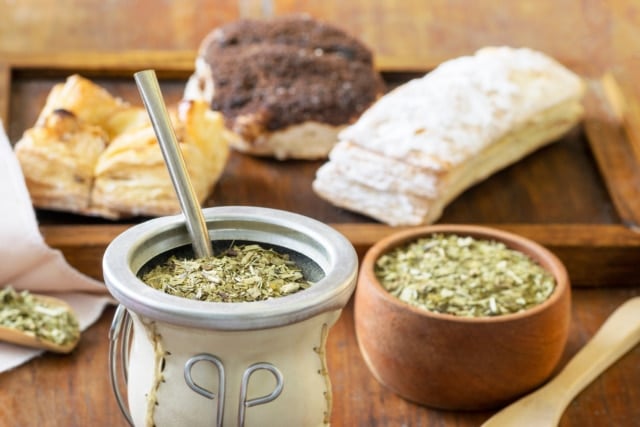
Mate
Are you a coffeeholic? If so, you’ll enjoy Mate, one of Brazil’s classic beverages, notable for its caffeine richness. This drink holds a cultural significance not only in Brazil.
But in various South American countries, including Chile, Argentina, and Uruguay. Mate is prepared by grounding and pounding freshly harvested mate leaves and then adding hot or cold water.
Caldo de Cana
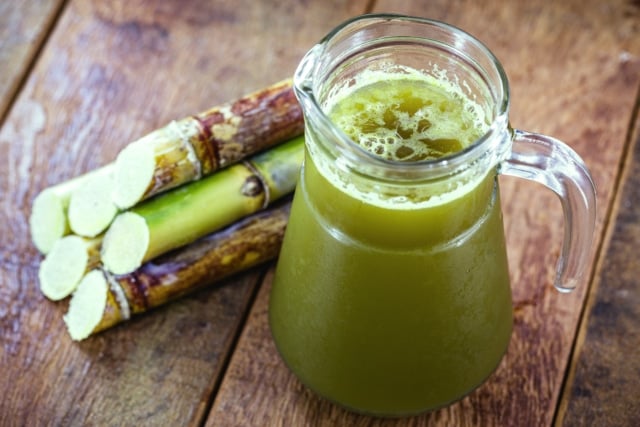
Caldo de Cana
Also known as Garapa, Caldo de Cana is a traditional Brazilian sweet drink that’s prepared from sugarcane. It’s made from the liquid that’s left after crushing a sugar cane in a machine.
It’s often served with ice, but it contains many calories. If you’re watching your weight, this drink may not be the best option.
Ingredients
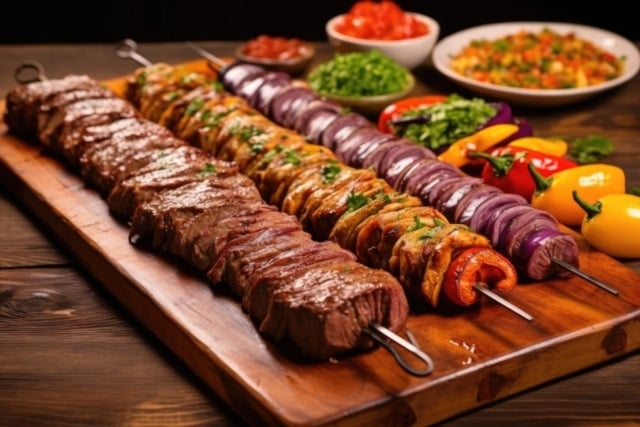
brazilian churrasco with different cuts of meat, created with generative ai
Since Brazilian cooking is a diverse fusion of different cultures, it can be daunting to pick up all the necessary ingredients to prepare your Brazilian meal. The ingredients incorporated in Brazilian dishes are as diverse as the cultures that influence Brazilian cuisine.
But still, some staples go into almost every Brazilian dish. To help you make your shopping list for your Brazilian cooking session, we created a list of the essential ingredients that form the backbone of Brazilian food.
- Black beans: Staples in many Brazilian dishes, including the iconic feijoada. Pinto beans and black-eyed are also parts of many Brazilian meals.
- Açaí: A deep purple bitter fruit that’s often blended with a sweetener and served as a smoothie or in a bowl.
- Cashews: Cashew fruits go into many traditional Brazilian dishes and drinks, such as cajuzinho and the cashew caipirinha.

Tapioca flour
- Tapioca flour: Gluten-free flour with a distinctive stretchy texture. It works as a thickening agent for many Brazilian stews and sauces and makes the base of pastries and desserts.
Other essential elements that go into many Brazilian dishes include Brazil nuts, Jambú, Coconut, Dendê oil, Pupunha, Heart of palm, Sugar cane, Guava and Pequi.
Herbs and Spices

Herbs and Spices
Brazilian cuisine features a wide range of herbs and spices that are familiar worldwide.
Even though many herbs and spices were introduced by the Portuguese and later immigrants from all over the world, there are some local oils, berries, nuts, and herbs that complement many dishes.
If you’re preparing to cook some Brazilian meals, here’s a list of all the essential herbs and spices:
- Cinnamon: Brazilians add powdered cinnamon to many dishes to add a sweet and spicy contrast to mild-flavored dishes and desserts.
- Salt: Many Brazilian dishes are prepared using only salt and lemon as spices.

Clove
- Clove: The Portuguese introduced clove to Brazil to add a lingeringly sweet and pungent flavor to their meals. It’s still widely used in many Brazilian dishes, especially pastries and sweets.
- Cilantro: In many Brazilian states, cilantro leaves and shoots are used as a garnish in salads and soups, as well as in meat and seafood dishes.
- Bay leaves: They’re added to many spicy meat and fish dishes to infuse milder flavors.

Cumin powder
- Cumin powder: Incorporated in many stews such as cabrito ao Molho and Barreado to provide a hint of bitterness.
- Annatto: A distinctive orange-red condiment that adds a slightly nutty, sweet flavor to many Brazilian dishes.
- Garlic: Many Brazilian traditional dishes like Refogado and Feijocada are prepared with garlic.
Other widely used herbs and spices in the Brazilian cuisine include Parsley, Turmeric, Ginger powder, Mint, Fennel and anise, Black peppercorn, Nutmeg, Pepper, Paprika and Allspice.
Brazilian Food Culture

Brazilian Food Culture
Brazilian food culture is a delectable mix of influences from its native people, Portuguese colonists, immigrants from Asia and Europe, and African slaves.
This is evident in the diversity of flavors and ingredients in Brazilian dishes. Brazilian cuisine also varies by region due to the country’s vast geography and rich cultural heritage.
Rice, beans, cassava, meat, and seafood are staples in most Brazilian dishes, while exotic fruits and spices add a touch of flavor to several main and side dishes. But what about the eating habits, meal structure, and etiquette? Well, let’s see.
Eating Habits

Eating Habits
Eating and drinking in Brazil are more like socializing activities rather than necessities. The first meal is breakfast or ‘café da manhã,’ which is typically consumed between 6 and 8:30 a.m. to align with school or work timings.
The main drink of Brazilian breakfast is coffee, which is enjoyed in various forms. Some enjoy it black with plenty of sugar, while others prefer to média, which is half-heated milk, half coffee. For food, Brazilians usually have pão francês or pão de queijo at breakfast.
Lunch is the second meal in Brazil, and it’s significant for socializing and unwinding. Brazilians often have lunch around noon or 1 p.m.
Most workers take a one-hour lunch break to enjoy their meals and conversations. Per-kilo restaurants are one of the most popular lunch spots in Brazil, where you pay based on your plate’s weight.
Typical lunch dishes include rice, meat, beans, fish, and a wide selection of vegetables and salads.
Dinner is the last meal of the day in Brazil, and it’s enjoyed around 7 p.m. or 8 p.m. It’s a wholesome meal that tends to be a family event as all family members gather and eat together. Brazilians often enjoy rice, beans, meat, pizza, lasagna, or stroganoff at dinner.
Meal Structure

Meal Structure
The Brazilian meal revolves around the staple foods of rice and beans that form the basis of multiple dishes. Feijoada is an ideal example of a traditional Brazilian meal that consists of a black bean stew with various types of meat.
Moreover, the concept of churrasco is deeply ingrained in Brazilian cuisine, which involves grilling various meat types accompanied by farofa and vinaigrette.
Etiquette

Etiquette
Dining etiquette is crucial in Brazil, especially in business settings. The essential norms include waiting for all the diners to be served before eating unless the service is really slow. Cutlery is used for most foods, but you can use a napkin to hold particular foods like bread and boned chicken.
Even though smoking is often allowed, it’s more respectful to wait until the meal is finished and go out for a smoke. As you can expect, noisy eating is considered impolite.
After finishing your meal, it’s customary to place your fork and knife parallel on the plate. Finally, avoid using toothpicks at the table. If necessary, excuse yourself to the restroom.
You might also be interested in…
#Brazilian #Food #Popular #Dishes #Secret #Recipe #Tips



